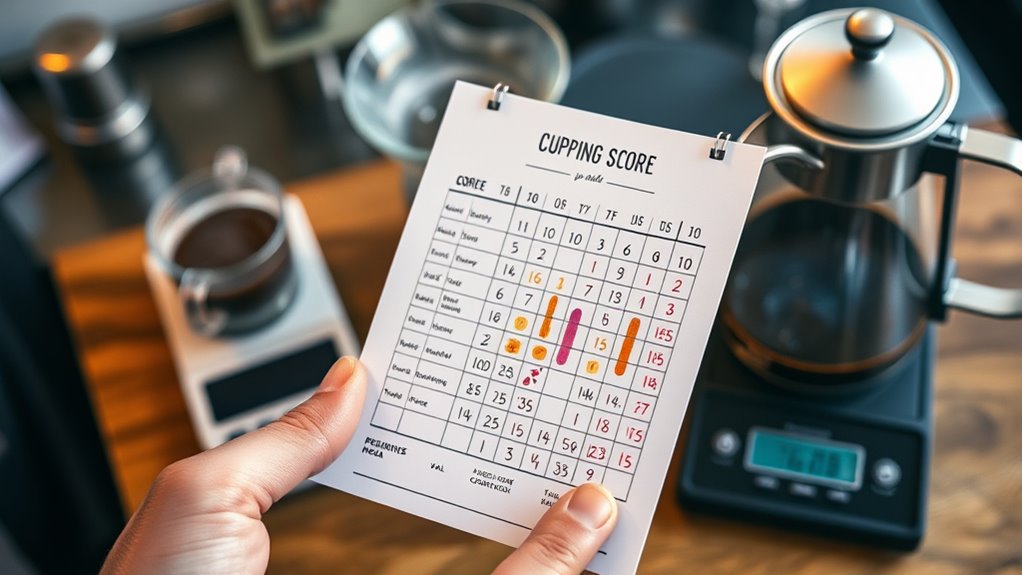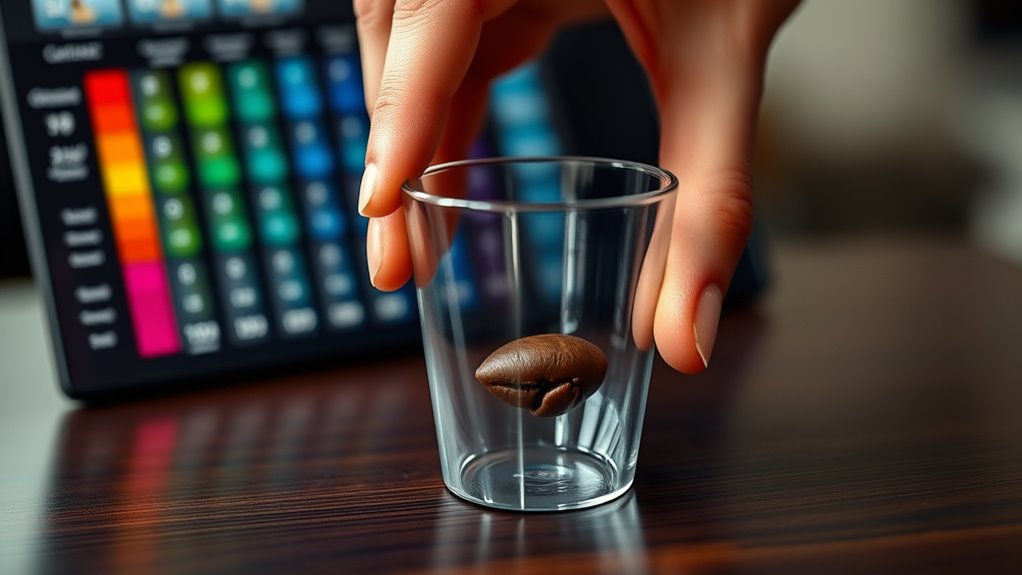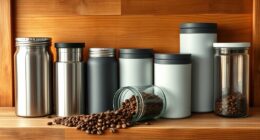To predict your flavor preferences using cupping scores, focus on the individual components like aroma, flavor, and aftertaste. Higher scores often mean more complex and vibrant profiles, which may match your liking for lively, layered coffees. Pay attention to patterns in scores that highlight specific notes or body types you enjoy. By comparing scores across different coffees and methods, you’ll better understand what appeals most to you, and you’ll uncover more about your taste preferences along the way.
Key Takeaways
- Analyze individual score components like aroma, flavor, and aftertaste to identify which attributes align with your taste preferences.
- Look for consistent high scores in specific flavor notes to predict enjoyment of similar aroma and taste profiles.
- Use overall cupping scores to gauge complexity and richness, indicating a preference for layered, nuanced flavors.
- Compare scores across different brewing methods to understand how preparation affects flavor perception and matches your palate.
- Track scoring patterns over time to refine your selections and predict future enjoyment based on preferred sensory attributes.
Understanding Cupping Scores and Their Components

Cupping scores are a standardized way to evaluate and compare coffee flavors systematically. They reflect various components like aroma, flavor, aftertaste, acidity, body, and balance. Cultural influences shape how these scores are interpreted, as different regions prioritize certain flavor qualities over others. For example, some cultures value bright acidity, while others focus on full-bodied profiles. Brewing techniques also play a role, since the method used—such as pour-over or French press—affects flavor extraction and, consequently, the scoring. Understanding these components helps you appreciate how cultural preferences and brewing choices influence cupping scores. By recognizing these factors, you can better predict how a coffee’s scored attributes align with your own flavor preferences. Additionally, cupping scores can be affected by the sensory perceptions of different tasters, emphasizing the importance of consistent evaluation standards.
How to Read and Interpret Cupping Scores

To interpret cupping scores effectively, you need to understand each scoring component and what it reveals about the coffee’s flavor. Analyzing these scores helps you compare flavor profiles and identify your preferences. By honing your skills in reading cupping scores, you can make smarter choices and better predict which coffees you’ll enjoy most. Paying attention to scoring accuracy can further refine your ability to assess coffee quality.
Understanding Scoring Components
Understanding the scoring components is essential for accurately interpreting cupping scores and evaluating coffee quality. When examining scores, focus on brew strength, which reflects the coffee’s body and richness, and aroma intensity, indicating how vibrant and inviting the coffee smells. These elements contribute markedly to the overall impression of a cup. A high aroma score suggests a complex and appealing scent profile, while a balanced brew strength ensures the coffee isn’t too weak or overpowering. Recognizing how these components influence the score helps you identify what aspects of the coffee you prefer. Keep in mind, scores are averages of multiple criteria, but understanding the individual components allows you to better predict flavor preferences and select coffees that match your taste. Additionally, understanding city dynamics can help you appreciate regional flavor profiles and their influence on cupping scores.
Analyzing Flavor Profiles
Interpreting cupping scores involves examining the detailed flavor profiles that contribute to your overall perception of a coffee. You’ll analyze notes like acidity, body, and aroma to understand the coffee’s character. Recognizing these elements helps you refine pairing techniques and select ideal brewing methods. Use the table below to interpret scores:
| Flavor Attribute | High Score (8-10) | Low Score (1-4) | Suggested Pairing/Brewing |
|---|---|---|---|
| Acidity | Bright, lively | Flat, dull | Light roasts, pour-over |
| Body | Full, creamy | Thin, watery | Espresso, French press |
| Aroma | Intense, complex | Weak, simple | Filter coffee, cold brew |
This analysis guides you in matching flavors with preferred brewing techniques and enhancing your overall coffee experience. Understanding cupping scores can also help you develop a more mindful approach to tasting and appreciating coffee nuances.
Comparing Cupping Results
When comparing cupping results, focus on the scores assigned to each flavor attribute to identify patterns and differences among coffees. Pay attention to how brewing techniques influence these scores; for example, a pour-over may highlight delicate fruity notes, while a French press might emphasize body and richness. Storage methods also impact flavor stability, so coffees stored properly tend to have more consistent scores. Look for trends across multiple cuppings—if a coffee consistently scores high in acidity and brightness, it might appeal to flavor preferences favoring lively profiles. Conversely, if storage or brewing adjustments cause score variations, consider these factors when interpreting results. Comparing cupping scores with these elements in mind helps you understand how preparation and storage influence flavor perception. Additionally, understanding how color accuracy and contrast ratio affect the perception of coffee in visual assessments can provide deeper insights into the overall sensory experience.
Comparing Cupping Scores Across Different Beverages

Comparing cupping scores across different beverages reveals how flavor profiles vary and can help identify which drinks appeal most to your preferences. By analyzing scores, you can see how brewing methods influence aroma evaluation and taste complexity. For example, a high score in brewed pour-over coffee might reflect bright acidity and intricate aroma layers, while a lower score in espresso could indicate a more intense, concentrated profile. Use this comparison to understand how different drinks suit your palate. The table below summarizes typical scoring patterns:
| Beverage | Brewing Method | Aroma Evaluation |
|---|---|---|
| Coffee | Pour-over | Bright, floral, complex |
| Tea | Steeping | Fragrant, smooth |
| Hot Chocolate | Boiling | Rich, sweet, comforting |
| Fruit Juices | Fresh pressing | Fresh, vibrant aroma |
| Energy Drinks | Carbonation | Bold, synthetic notes |
This helps you interpret cupping scores more effectively. Additionally, understanding how juice extraction affects flavor intensity can provide deeper insight into how beverages are evaluated.
Recognizing Flavor Profiles Associated With Score Ranges

Analyzing cupping scores helps you identify specific flavor profiles associated with different score ranges, making it easier to predict your preferences. Higher scores often correlate with intense aroma profiles, where aroma intensity signals a vibrant, lively cup. These coffees tend to have a well-balanced aftertaste with a satisfying length, indicating complexity and richness. Conversely, lower scores may feature milder aroma intensity and shorter aftertaste, suggesting a more subdued flavor experience. Recognizing these patterns allows you to anticipate your enjoyment based on score ranges. For example, a high score usually signals a cup with bold aroma and lingering aftertaste, while a lower score might point to a softer, more delicate profile. This understanding helps refine your choices and aligns your selections with your flavor preferences. Additionally, understanding breakdown of scoring systems can further enhance your ability to interpret cupping scores accurately.
Applying Cupping Scores to Personal Taste Preferences

Applying cupping scores to your personal taste involves using those numerical evaluations as a guide to select coffees that match your flavor preferences. Focus on how scent intensity and aroma complexity influence your enjoyment. Higher scores often indicate vibrant, well-balanced profiles, but your preferences may lean toward subtler or more complex aromas. Understanding the types of paint sprayers can help you appreciate the nuances in flavor profiles, much like choosing the right spray method for a smooth finish. To tailor your choices: – Prioritize coffees with high aroma complexity if you love layered, nuanced scents. – Seek out those with balanced scent intensity if you prefer a more subtle aroma experience. – Use scores to compare how different coffees’ scent profiles align with your flavor preferences, helping you refine your selections over time.
Tips for Using Cupping Scores to Discover New Favorites

When exploring new coffees, start by focusing on specific flavor notes that catch your interest. Compare cupping scores to see which coffees consistently appeal to you and which ones stand out. This approach helps you identify your preferences and discover new favorites more effectively. Paying attention to flavor profiles can deepen your understanding of what makes each coffee unique and enhance your tasting skills.
Focus on Flavor Notes
By paying close attention to the flavor notes highlighted in your cupping scores, you can uncover new tastes that resonate with your preferences. Focus on aroma complexity to identify subtle scent layers that signal unique flavor profiles. Consider the aftertaste length, as longer finishes often indicate more refined and memorable coffees. To deepen your understanding:
- Notice which flavor notes consistently appear in your top scores, guiding you toward your favorites.
- Pay attention to aroma notes that excite your senses, revealing hidden flavor potential.
- Track the aftertaste, especially if it’s lingering and pleasant, as it can distinguish high-quality coffees. Additionally, exploring unique and wicked planters can inspire new ways to enjoy your coffee experience by integrating creative presentation methods.
Compare Cupping Scores
Comparing cupping scores across different coffees allows you to identify patterns and preferences more effectively. For example, higher scores in Ethiopian botanical varieties often correlate with bright, fruity notes. Notice how coffees brewed with pour-over methods tend to highlight delicate floral flavors, while French press brews emphasize body and richness. Use this table to visualize your discoveries:
| Coffee Type | Preferred Brewing Method | Cupping Score Trend |
|---|---|---|
| Ethiopian Botanical | Pour-over | Higher scores for brightness |
| Central American | Chemex or Aeropress | Balanced, complex flavors |
| Sumatra (Wild) | French press | Rich, full-bodied scores |
| Colombian (Standard) | Drip or espresso | Consistent, smooth notes |
Frequently Asked Questions
How Accurate Are Cupping Scores in Predicting Individual Flavor Preferences?
Cupping scores can give you a useful starting point, but they aren’t perfectly accurate for predicting individual flavor preferences. Quantitative analysis helps identify general trends, yet sensory variability among tasters means personal tastes may differ. You might find that some coffees score high but aren’t your favorites. So, while cupping scores offer valuable insights, trusting your own palate remains key to discovering what you truly enjoy.
Can Cupping Scores Be Influenced by Subjective Biases?
Did you know that studies show sensory subjectivity can affect up to 30% of cupping scores? Yes, bias influence is real, and it impacts how you perceive flavors. Your personal preferences, mood, or even expectations can skew results. So, while cupping scores are valuable, they’re not immune to subjective biases. Recognizing this helps you interpret scores more critically and understand that individual taste is often shaped by personal bias.
Are Cupping Scores Consistent Across Different Cupping Sessions?
You might wonder if cupping scores stay consistent across sessions. Due to standardization challenges and scoring variability, consistency can be tricky. Factors like different tasters, environmental changes, and slight method differences can all influence scores. To improve reliability, it is crucial to establish clear protocols, calibrate tasters regularly, and document conditions. While some variability exists, consistent practices help you achieve more comparable cupping scores over multiple sessions.
How Do Cultural Differences Affect the Interpretation of Cupping Scores?
Cultural taste shapes how you interpret cupping scores, much like how a local dialect colors a conversation. Regional preferences influence what flavors you value, making scores seem more or less favorable depending on your background. You might prioritize acidity or sweetness differently based on your cultural context. Recognizing these differences helps you better understand cupping scores and avoid misjudging a coffee’s potential across diverse markets.
What Are Common Pitfalls When Using Cupping Scores for Flavor Prediction?
When using cupping scores for flavor prediction, be aware of common pitfalls like sample bias and scoring inconsistency. You might overlook diverse palates or favor certain profiles, skewing results. Additionally, inconsistent scoring methods can lead to unreliable data. To improve accuracy, confirm your samples are representative, and establish standardized scoring criteria so that evaluations remain consistent across sessions. This helps you make better, more informed predictions about flavor preferences.
Conclusion
By understanding and using cupping scores, you can better predict which flavors will suit your taste buds. Did you know that coffees rated above 85 often appeal to enthusiasts seeking complex, balanced profiles? With this knowledge, you can confidently explore new beverages and find your favorites. So, start comparing scores, recognize flavor ranges, and let cupping scores guide your tasting journey—your perfect cup might be just a score away!









